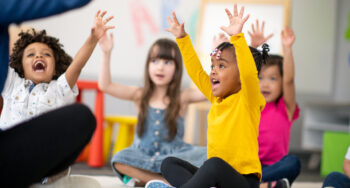Jennifer Diehl, Heather Skibbins
First Grade: English-instructed classroom with numerous Multilingual Learners who have a variety of home language and cultural backgrounds.
From the welcome greeting on the door in various languages to the first peek into Ms. Welch’s first-grade classroom, it is clear that this is a classroom of children and families from many places in the world. Today, as students are working at their tables writing or doing language arts activities, Mexican folk music is playing softly. Other days, it is music from other places in the world. Thanks to the support of the school librarian, Ms. Welch has been able to identify and borrow books in the languages of the families to display in the Class Library Corner. A bulletin board is filled with photos of the children’s families. Posters, depicting different feelings (sadness, joy, etc.) and including children in a rainbow of racial/ethnic backgrounds, are arrayed around the “I Feel___” bulletin board where students hang drawings and writing whenever they want to express their feelings.
There is no question that this room belongs to and is representative of this group of children.
From the start of the year, the basic theme of “similarities and differences” has permeated the curriculum, encouraging a value of diversity. Students compare and contrast their experiences and family structures, contrast books by different authors covering the same theme, and examine similarities and differences in redwood trees compared to apple trees for their Plants Unit. They have become proficient in using compare and contrast language, and using Venn Diagrams to display such data. Their writing and graphics adorn the walls. There is no question that this room belongs to and is representative of this group of children. A big collaborative art project takes up a portion of one wall as children work on a mural of their community, including the buildings and landmarks they see in their neighborhood. All around, children see themselves and the products of their work (their drawings, their writing) on the walls. This is their classroom.
Reflection questions
- What features of Ms. Welch’s class acknowledge children’s multiple identities and support their learning? What might be a follow-up activity to build on the work that is already displayed in the classroom?
- Ms. Welch would describe their lesson as “culturally relevant.” What does this term mean to you? What are key features of a “culturally relevant lesson?”
- What is one takeaway that you can apply to your own classroom environment for supporting Multilingual Learners?


